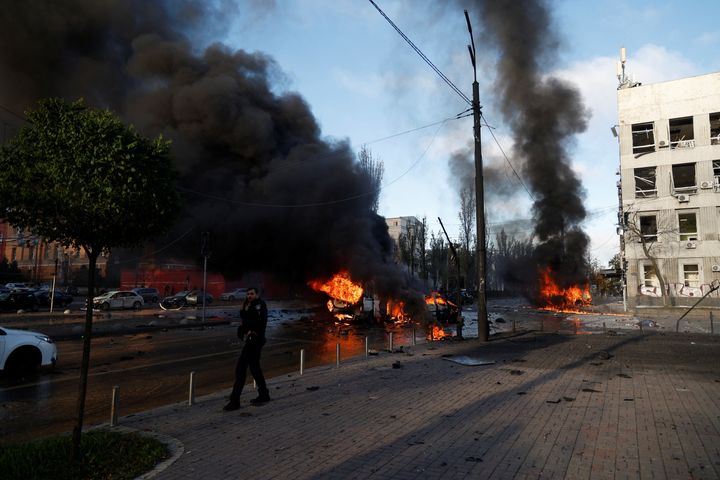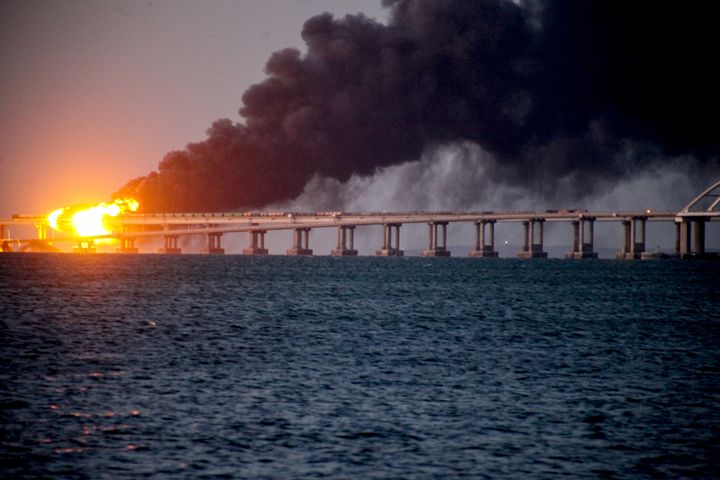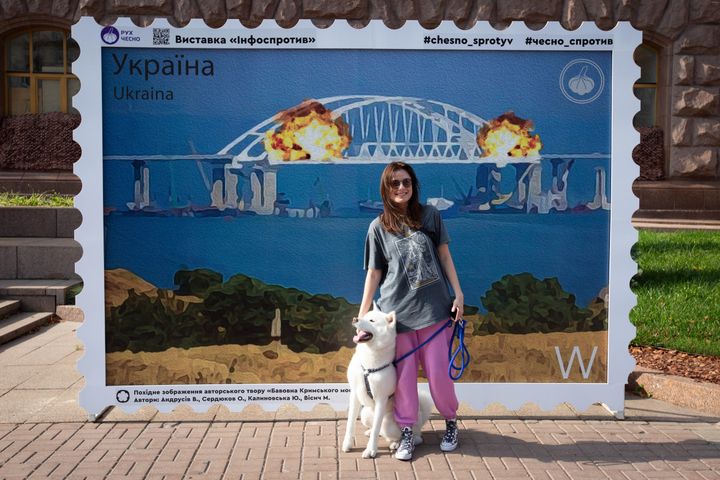
Russia has just launched another offensive, this time striking all over Ukraine, as Vladimir Putin doubles down on his war effort.
Here’s what you need to know.
What’s happened?
Kyiv, the capital of Ukraine, reported “several explosions” on Monday morning just after 8am local time, leading to numerous casualties.
This is a particularly noteworthy moment, partly because government offices (based in the capital) have not been targeted much throughout the war.
Russia’s inability to seize the capital back in the early days of its invasion of Ukraine was also seen as a source of great embarrassment, especially because Moscow was expecting to take it within just three days.
Seven months later, the mayor of Kyiv, Vitali Klitschko, said there have been “several explosions in the Shevchenkivskyi district – in the centre of the capital”.
Ukrainian president Volodymyr Zelenskyy also gave a live video address from Kyiv amid the strikes, admitting that it was a “difficult” day.
A Ukrainian newspaper, the Kyiv Independent, has reported that there were “power outages” across the capital after the attack.
Clips shared on social media show that many civilian areas have been destroyed in the ongoing strikes.
In response to the attacks, Ukraine’s defence minister, Oleksii Reznikov, said on Twitter: “The only thing they [Russia] demolish irreversibly is the future of [Russia] – a future of a globally despised rogue terrorist state.”
Russia is believed to have launched 83 missiles on Monday morning alone, according to the Ukrainian air force, striking cities all across the country. More than 43 of these missiles were reportedly struck down.
Putin confirmed the Russian strikes a few hours later, saying long-range missiles targeted energy, military and communications facilities.
He promised a “harsh” response to any other “terrorist” attacks on Russian territory – presumably a reference to the attacks on the Crimea-Russia bridge on Saturday.
It’s not just the capital either. Cities in the east such as Dnipro and Zaporizhzhia, and in the west, such as Ternopil and Lviv, have all been targeted, too.
Russia has been concentrating its war efforts along its Ukrainian border to the east in recent months – including annexing some regions there – so the shift to the west shows Putin is throwing everything he can at the war right now.
Moscow’s previous attempts to invade Kyiv and claim the west of the country were unsuccessful, as Russia was forced back by the Ukrainian forces.
As the UK’s work and pensions minister Victoria Prentis told Sky News on Monday, this proves “we are very much in the midst of war” – despite Ukraine’s success with its counteroffensive over the last few weeks.
Why is Putin upping the ante now?
It’s widely believed that the Russian president’s new acts of aggression are in response to the recent attacks on a bridge connecting Crimea to Russia. It was of critical importance to connect trade between the two.
Putin has already accused Ukraine of attacking the bridge, claiming it is an “act of terrorism” after Russia claimed three people were killed. Parts of the car section of the bridge fell into the Black Sea.
The bridge was supposedly a personal project for Putin and seen as a symbol of Moscow’s power. Repairs have already begun, and traffic was able to cross later on Saturday, hours after the blast.
Russia has now increased its security around the infrastructure.
Crimea, a Ukrainian peninsula which was annexed by Russia in 2014, was considered a Russian stronghold until recently.
Explosions in the region along with Ukraine’s vow to reclaim all of its land appeared to signal that Kyiv might be trying to retrieve it. However, the Ukrainian government has not taken responsibility for either the explosions in Crimea or the bridge.

As the UK minister Prentis told Sky News: “I don’t think the Ukrainians have taken responsibility for that destruction – we have to be very careful, we don’t know who was responsible for it.”
Still, after the bridge was targeted, many Ukrainians were anticipated a significant backlash from Russia in response to the bridge attack.
Many also celebrated the downfall of the bridge, posing in front of a stamp model of the explosions over the weekend.

Does this mean nuclear war is more likely?
The new wave of aggression could prove to be yet another key moment in the war.
Mykhailo Podolyak, an adviser to Ukrainian president Volodymyr Zelenskyy, dubbed these attacks as “deliberate” and further proof of “the Kremlin’s terrorist inadequacy”.
“Russia is not capable of fighting on battlefield, but capable of murdering civilians. Instead of talking we need air defence, MLRS, longer-range projectiles.”
However, former US ambassador to Ukraine, Steven Pifer, said that Putin does not want the war to turn nuclear, despite his ambiguous threats.
He told Sky News: “They constitute Russia’s strongest claim to great power status, and Putin and [the] Kremlin seek to project [the] image of Russia as [a] great power.”
He claimed that the use of nuclear power in Ukraine would not necessarily have decisive military impact, and would likely push Russia’s allies in China and India away.
The UK’s ministry of defence claimed that the new strikes follow increasing “pressure on Russian forces” in the north-eastern and southern regions of Ukraine.
It said Russia is pushing its “grinding Donbas offensive” – in the east of Ukraine – amid “serious threats on its operational flanks”.
The MoD claimed this all emphasised the “imperative to deliver operational success while also underlining the inflexible operational design which has undermined its plans thus far”.
The West has reiterated its ongoing support for Ukraine, with leaders across Europe speaking to Zelenskyy within hours of the attacks.
UK foreign secretary James Cleverly said that the Russian attacks on civilians leaders were “unacceptable” and a “demonstration of weakness by Putin, not strength”.
